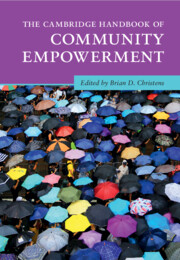Book contents
- The Cambridge Handbook of Community Empowerment
- Cambridge Handbooks in Psychology
- The Cambridge Handbook of Community Empowerment
- Copyright page
- Contents
- Figures
- Tables
- Contributors
- Building Community Power
- Part I Organizing and Activism
- Part II Participatory Governance
- Part III Civil Society and Coalitions
- Part IV Enterprise
- Part V Participatory and Community Arts
- Part VI Education and Engaged Research
- 20 Action Civics
- 21 Gender–Sexuality Alliances
- 22 Youth Participatory Action Research in School Settings
- 23 Community-Based Education
- 24 Community-Engaged Research
- Concluding Thoughts on Building Community Power
- Contributor Details
- Index
- References
21 - Gender–Sexuality Alliances
from Part VI - Education and Engaged Research
Published online by Cambridge University Press: 18 April 2024
- The Cambridge Handbook of Community Empowerment
- Cambridge Handbooks in Psychology
- The Cambridge Handbook of Community Empowerment
- Copyright page
- Contents
- Figures
- Tables
- Contributors
- Building Community Power
- Part I Organizing and Activism
- Part II Participatory Governance
- Part III Civil Society and Coalitions
- Part IV Enterprise
- Part V Participatory and Community Arts
- Part VI Education and Engaged Research
- 20 Action Civics
- 21 Gender–Sexuality Alliances
- 22 Youth Participatory Action Research in School Settings
- 23 Community-Based Education
- 24 Community-Engaged Research
- Concluding Thoughts on Building Community Power
- Contributor Details
- Index
- References
Summary
Gender–sexuality alliances (GSAs) are school-based clubs that provide space for LGBTQ+ youth and their heterosexual cisgender peer allies to socialize, build community, provide social-emotional support, access LGBTQ+-affirming resources, and advocate against discrimination. In this chapter, we review the historical underpinnings of GSAs; their contemporary roles in schools; the ways in which GSAs harness their collective power to advocate and promote social justice for LGBTQ+ people; the ways in which youth experience empowerment through their GSA involvement; and how GSA research can be used by school administrators, GSA advisors, and youth leaders. Finally, we highlight avenues for future research that could further aid GSAs in their aspirations to promote thriving among their members and social justice in their schools.
Keywords
- Type
- Chapter
- Information
- The Cambridge Handbook of Community Empowerment , pp. 532 - 555Publisher: Cambridge University PressPrint publication year: 2024



